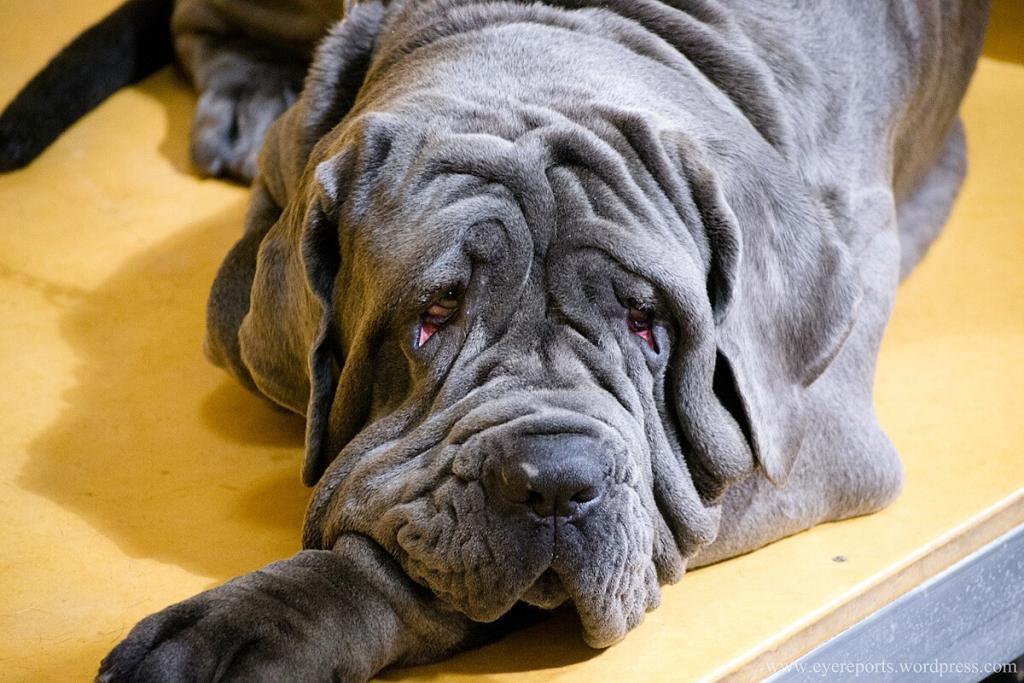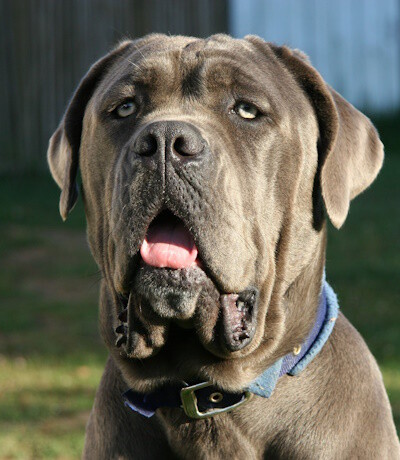As the Colosseum stands committed in the heart of Rome, so does the Neapolitan Mastiff in guardianship, embodying strength and vigilance. You appreciate the value of a steadfast protector, and in the Neapolitan Mastiff, you’ll find a colossal ally, draped in folds of skin that enhance its intimidating presence.
While its formidable appearance may suggest a fierce nature, this breed harbors a gentle spirit towards those it holds dear. As you consider the layers of the Neapolitan Mastiff’s character, from its unwavering loyalty to its dignified calm, you might wonder how such a powerful creature can exhibit such tenderness. However, beneath the surface of this Italian sentinel lie complexities that demand a deeper understanding; its needs and potential health issues are as significant as its muscular frame.
To fully grasp the essence of this noble beast, one must explore the balance of care, training, and companionship that shapes its life.
- Noise Level
- Energy
- Sociability
- Trainability
- Care
- Health
Overall
Summary
The Neapolitan Mastiff is characterized by moderate noise levels, moderate to high energy levels, moderate sociability, moderate trainability, and requires moderate to high care. They typically enjoy good health overall.
Neapolitan Mastiff: Traits, Temperament, and Care Guide
The Neapolitan Mastiff, a breed steeped in history, possesses traits that demand meticulous care and a deep understanding of its protective nature. As a cherished member of the guardian breed family, you’ll find these gentle giants are affectionate with their families and reserved around strangers. Their loyalty is unparalleled, yet you must commit to early socialization to nurture their well-balanced temperament.
Their loose, wrinkled skin, massive head, and imposing size may seem daunting, but these features are hallmarks of their heritage as working and guard dogs. Unfortunately, these characteristics can lead to orthopedic problems, such as hip dysplasia. Therefore, regular exercise, grooming, and vet check-ups are non-negotiable to maintain their well-being.
Embrace your role in their life; understand that you’re not just owning, but joining a legacy.
Exploring the Characteristics of the Neapolitan Mastiff
Delving into the characteristics of the Neapolitan Mastiff, you’ll discover a breed whose robust frame and loyal heart have been shaped by its storied past as a Roman war dog. Originating from southern Italy, these massive dogs have evolved into ferocious guards due to their protective nature. Despite their large size, they are gentle and affectionate with their families.
Here’s a snapshot to help you understand their essence:
| Characteristic | Description | Relevance |
|---|---|---|
| Size & Build | Large with a powerful, muscular frame | Intimidating presence, effective guard dogs |
| Temperament | Protective, loyal, yet gentle with family | Suits a family seeking a safeguard and companion |
| Care Requirements | Daily exercise, consistent training, socialization | Prevents health issues, ensures balanced behavior |
As an Italian dog breed, the Neapolitan Mastiff adheres to a breed standard that emphasizes its grand stature and the need for an active lifestyle to maintain its well-being.
Neapolitan Mastiff: A Comprehensive Profile and Guide

As you consider adding a Neapolitan Mastiff to your family, it’s crucial to fully understand their distinct characteristics and care requirements.
This breed’s ancient lineage and formidable presence are matched by a complex set of needs that range from health monitoring to consistent training.
Your empathetic approach and informed decisions will be pivotal in fostering a nurturing environment for this majestic and loyal companion.
Everything You Need to Know
Understanding the Neapolitan Mastiff requires appreciating its historical role as a formidable guardian. Now balanced with a nurturing family temperament that demands responsible ownership, the Neapolitan Mastiff is a breed recognized by the American Kennel Club and the Federation Cynologique Internationale. As the quintessential Italian Guardian, it carries a legacy.
- Embrace their protective nature:
- Feel the security of having one of the most loyal guard dogs.
- Cherish the gentleness they show to their families.
- Be mindful of their needs:
- Acknowledge the importance of early socializing and puppy kindergarten.
- Be proactive in managing genetic health problems through regular vet check-ups.
You’ll find that basic obedience training and an empathetic, analytical approach to their care are essential. As you welcome this majestic breed into your life, you’re not just getting a pet; you’re gaining a devoted guardian and a loving family member.
Discovering the Temperament
When considering a Neapolitan Mastiff as a pet, it’s vital to recognize that its temperament encompasses fierce loyalty to family and natural caution around strangers, necessitating a commitment to early socialization and consistent training.
These powerful dogs are renowned guard dogs. Always alert and aware, they are ready to protect their loved ones with a resolve stemming from the Neapolitan Mastiffs’ roots in Italy. They bond deeply, exhibiting a gentle and affectionate nature within the safety of the family unit.
Your Neapolitan Mastiff’s intimidating appearance is matched by a temperament that requires understanding and empathy. As a confident dog, it needs a leader who values basic obedience and can guide it through training and socializing, ensuring that its protective instincts are well-managed and positive.
Neapolitan Mastiff: Is It a Good Fit for Families?
You might wonder if the Neapolitan Mastiff’s protective nature aligns with the dynamics of a family environment.
Consider their need for early socialization and consistent training to ensure they’re well-behaved around children.
Balancing their affectionate disposition with their imposing size and exercise needs is crucial for harmonious family life.
Assessing Neapolitan Mastiff’s Compatibility with Families and Kids
Assessing the Neapolitan Mastiff’s compatibility with families and kids requires considering their protective nature and unique temperament traits to ensure a harmonious household dynamic.
- Neapolitan Mastiff puppies:
- Effort training and socializing are crucial for integrating them into your family circle.
- They bond closely to their people, offering unconditional love and becoming the perfect companion.
This breed’s good qualities shine when they feel part of the home or yard. It’s a good idea to take the time to welcome someone new into their space. They can be taught to trust and accept others with patience and empathy, reinforcing the bond they share with their family.
Neapolitan Mastiff Adaptability Quirks
Understanding the adaptability quirks of the Neapolitan Mastiff is crucial for potential owners, as their protective instincts and maintenance needs require a dedicated and experienced hand. Originating as guard dogs, Neapolitan Mastiffs carry a dominant gene for guardianship. Recognized by the Fédération Cynologique Internationale (FCI), they’re known for loyalty and require plenty of effort training to shape their behavior.
As a Neapolitan Mastiff puppy matures, you’ll find it lounging around the home, yet beware they’re notorious for passing gas. Regular exercise is essential to prevent weight gain, a precursor to elbow dysplasia. Cleaning their facial wrinkles is part of the daily grooming ritual.
The United States Neapolitan Mastiff Club can provide support and advice, ensuring you and your gentle giant find a place where you both feel you belong.
Neapolitan Mastiff Obedience Tips
Adopting effective training strategies that align with your Neapolitan Mastiff’s temperament is crucial. You’ll need to be patient and consistent, as their massive size and strength require a special approach that balances firmness with positive reinforcement.
Early socialization and regular exercise are essential components that contribute to their obedience and overall well-being.
Effective Training Strategies
To effectively train your Neapolitan Mastiff, it’s essential to start early, employing firm and consistent training techniques that foster both good behavior and socialization. As a member of the breed renowned since the beginning of the Bronze Age for its protective instincts, your Neapolitan Mastiff will need a lot of guidance to ensure they develop a well-rounded temperament, especially toward dogs and people they’re unfamiliar with.
| Age to Start | Training Focus | Owner’s Role |
|---|---|---|
| Young Age | Basic Commands | Guide |
| Puppyhood | Socialization | Socializer |
| Adolescence | Obedience | Enforcer |
| Adulthood | Advanced Tasks | Refiner |
| Throughout | Exercise | Motivator |
As an experienced owner, you’ll need to put in plenty of dedication. Consider enrolling in training classes to provide structure and reinforce effective training strategies. Patience and empathy go a long way in cultivating a trusting relationship with your gentle giant.
Exercise and Grooming Needs
Balancing gentle play with short, leashed walks, the Neapolitan Mastiff’s exercise and grooming routines are essential to maintaining their health and managing their distinctive physical characteristics. To keep your massive companion in top shape, allocate 20 to 30 minutes daily for exercise to prevent obesity and release pent-up energy.
This big dog benefits from a securely fenced area, where it can roam freely without overexerting its joints.
Regular brushing is pivotal to remove dead hair and maintain their short coat. Pay particular attention to cleaning the Mastiff’s skin folds with a damp cloth to thwart infections.
A shelter or rescue may offer guidance on exercising and grooming your adult Neapolitan, ensuring you can handle their high-maintenance needs with confidence and empathy.

Health Considerations
Considering a Neapolitan Mastiff as your companion, you must know their potential health challenges. These canines are susceptible to hip dysplasia and heart conditions, which could affect their quality of life.
Understanding their average lifespan of 8-10 years and the necessity of regular health check-ups will help you provide the best care for your gentle giant.
Common Health Issues and Lifespan
Understanding the common health issues in Neapolitan Mastiffs, such as hip dysplasia and bloat, is crucial for owners to manage their pets’ wellbeing and extend their typical 8-10 year lifespan.
As your Neapolitan Mastiff matures into adulthood, being vigilant about their health is paramount. Problems in the breed, like the ones mentioned, require regular veterinary check-ups for early detection and management.
Your commitment to their health also involves regular exercise to prevent obesity, which can exacerbate joint issues. Moreover, grooming isn’t just for their imposing appearance which can be unnerving; it’s essential for their skin and coat health.
Rescue organizations and clubs recognizing the breed often provide resources to help you care for this noble dog, even if you’re a novice dog owner.
Embrace your role in safeguarding your Neapolitan Mastiff’s health to cherish every moment of their companionship.
Is Neapolitan Mastiff the Right Dog for You?
Considering the Neapolitan Mastiff’s specific needs and characteristics, you should carefully evaluate whether this breed’s protective nature and size fit well with your lifestyle and experience with large dogs. Neapolitan Mastiffs aren’t just sizable companions; they’re formidable in any home. They ensure that anyone else’s intrusion is under their watchful eye, often becoming loyal best friends to those they protect.
Consider whether you’re prepared to bring home an adult dog that requires a large living space, consistent training, and can live harmoniously with any existing companion animals. They’re a commitment, with needs ranging from regular grooming to prevent health issues, to daily exercise for their well-being. Can you provide the structured, loving environment a Neapolitan Mastiff needs to thrive?
Conclusion
In conclusion, as you consider the noble Neapolitan Mastiff for your home, note that despite their formidable appearance, they’re surprisingly affectionate with an average lifespan of 8-10 years—a statistic that underscores the need for dedicated care.
Balancing strength with tenderness, these guardians require a knowledgeable and compassionate owner. Ensure you’re prepared for the commitment; their well-being depends on it, as does the enriching bond you stand to gain.
